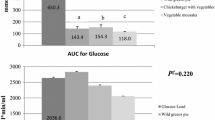Abstract
There is a very high prevalence of diabetes in India today which is increasing on a North to South axis. In addition to lifestyle changes, Indian people may be more susceptible to insulin resistance. Observational studies suggest that the consumption of diets with a low glycemic impact is associated with a reduced risk of diabetes. Maltitol is a bulk sweetener belonging to the polyols family and exhibiting a low glycemic response (GR). Genetic background has already been mentioned as an influent factor in modulating the GR of various foods. So, assessing glucose homeostasis including glycemic and insulinemic responses (IR) after maltitol consumption in Indians may be helpful in gaining a better understanding of this result from a physiological standpoint. The objective of this clinical study was to evaluate the GR and IR of maltitol in healthy Indian volunteers. The protocol followed Food and Agriculture Organization (FAO) recommendations. After an overnight fast, GR and IR of maltitol and reference (glucose) were measured on 12 subjects (50 g dissolved in 150 ml of mineral water). Glucose tolerance was assessed both before and after testing, the subjects being randomly allocated either to the maltitol or the glucose groups. Both glucose and insulin plasma concentrations were assessed in venous blood. Mean blood glucose levels were significantly lower after the consumption of maltitol compared with glucose from time points 15 to 90 min. GR of maltitol was found to be 20.4 ± 9.3 % of glucose GR. After maltitol consumption, the mean insulin blood levels were significantly lower from time points 15 to 120 min compared with the reference subjects. IR of maltitol was found to be 17.8 ± 9.9 % of glucose IR. We confirmed that the maltitol GR in healthy Indians is low. Moreover, maltitol displays a very low insulinemic response which may be of interest for diabetics in India.


Similar content being viewed by others
Abbreviations
- FAO/WHO:
-
Food and Agriculture Organization/World Health Organization
- GR:
-
Glycemic response
- iAUC:
-
Incremental area under the curve
- IR:
-
Insulinemic response
- NaF:
-
Sodium fluoride
- SD:
-
Standard deviation
- SEM:
-
Standard error of the mean
References
Mohan V, Sandeep S, Deepa R, Shah B, Varghese C. Epidemiology of type 2 diabetes: Indian scenario. Indian J Med Res. 2007;125(3):217–30.
Shaw JE, Sicree RA, Zimmet PZ. Global estimates of the prevalence of diabetes for 2010 and 2030. Diabetes Res Clin Pract. 2010;87(1):4–14.
Shetty P. Public health: India’s diabetes time bomb. Nature. 2012;485(7398):S14–6.
Weber MB, Oza-Frank R, Staimez LR, Ali MK, Narayan KM. Type 2 diabetes in Asians: prevalence, risk factors, and effectiveness of behavioral intervention at individual and population levels. Annu Rev Nutr. 2012;32:417–39.
Mohan V, Deepa R, Deepa M, Somannavar S, Datta M. A simplified Indian Diabetes Risk Score for screening for undiagnosed diabetic subjects. J Assoc Physicians India. 2005;53:759–63.
Scully T. Diabetes in numbers. Nature. 2012;485(7398):S2–3.
Ramachandran A, Snehalatha C. Current scenario of diabetes in India. J Diabetes. 2009;1(1):18–28.
Schulze MB, Manson JE, Ludwig DS, Colditz GA, Stampfer MJ, Willett WC, et al. Sugar-sweetened beverages, weight gain, and incidence of type 2 diabetes in young and middle-aged women. JAMA. 2004;292(8):927–34.
Imfeld TN. Clinical caries studies with polyalcohols. A literature review. Schweiz Monatsschr Zahnmed. 1994;104(8):941–5.
Portmann MO, Kilcast D. Psycho-physical characterization of new sweeteners of commercial importance for the EC food industry. Food Chem. 1996;56(3):291–302.
Lee A, Wils D, Zumbe A, Storey DM. The comparative gastrointestinal responses of children and adults following consumption of sweets formulated with sucrose, isomalt and lycasin HBC. Eur J Clin Nutr. 2002;56(8):755–64.
Ruskone-Fourmestraux A, Attar A, Chassard D, Coffin B, Bornet F, Bouhnik Y. A digestive tolerance study of maltitol after occasional and regular consumption in healthy humans. Eur J Clin Nutr. 2003;57(1):26–30.
Thabuis C, Cazaubiel M, Pichelin M, Wils D, Guerin-Deremaux L. Short-term digestive tolerance of chocolate formulated with maltitol in children. Int J Food Sci Nutr. 2010;61(7):728–38.
Beards E, Tuohy K, Gibson G. A human volunteer study to assess the impact of confectionery sweeteners on the gut microbiota composition. Br J Nutr. 2010;104(5):701–8.
Thabuis C, Herbomez AC, Desailly F, Ringard F, Wils D, Guerin-Deremaux L. Prebiotic-like effects of SweetPearl® Maltitol through changes in caecal and fecal parameters. Food Nutr Sci. 2012;3:1375–81.
Livesey G. Health potential of polyols as sugar replacers, with emphasis on low glycemic properties. Nutr Res Rev. 2003;16(2):163–91.
Pratt M, Lightowler H, Henry CJ, Thabuis C, Wils D, Guerin-Deremaux L. No observable differences in glycemic response to maltitol in human subjects from 3 ethnically diverse groups. Nutr Res. 2011;31(3):223–8.
Rizkalla SW, Luo J, Wils D, Bruzzo F, Slama G. Glycemic and insulinemic responses to a new hydrogenated starch hydrolysate in healthy and type 2 diabetic subjects. Diabetes Metab. 2002;28(5):385–90.
Brouns F, Bjorck I, Frayn KN, Gibbs AL, Lang V, Slama G, et al. Glycemic index methodology. Nutr Res Rev. 2005;18(1):145–71.
Staimez LR, Weber MB, Ranjani H, Ali MK, Echouffo-Tcheugui JB, Phillips LS, et al. Evidence of reduced beta-cell function in Asian Indians with mild dysglycemia. Diabetes Care. 2013;36(9):2772–8.
Chiu KC, Cohan P, Lee NP, Chuang LM. Insulin sensitivity differs among ethnic groups with a compensatory response in beta-cell function. Diabetes Care. 2000;23(9):1353–8.
Tabak AG, Herder C, Rathmann W, Brunner EJ, Kivimaki M. Prediabetes: a high-risk state for diabetes development. Lancet. 2012;379(9833):2279–90.
Livesey G. Tolerance of low-digestible carbohydrates: a general view. Br J Nutr. 2001;85 Suppl 1:S7–16.
Acknowledgments
This study was sponsored by ROQUETTE (Lestrem, France).
AS and PM conducted the experimental study and performed statistical analysis. CT and LGD worked on the protocol. CT interpreted the results and wrote the manuscript. BR, TG, DW, and LGD participated and revised the manuscript.
Author information
Authors and Affiliations
Corresponding author
Rights and permissions
About this article
Cite this article
Thabuis, C., Rodriguez, B., Gala, T. et al. Evaluation of glycemic and insulinemic responses of maltitol in Indian healthy volunteers. Int J Diabetes Dev Ctries 35, 482–487 (2015). https://doi.org/10.1007/s13410-015-0321-4
Received:
Accepted:
Published:
Issue Date:
DOI: https://doi.org/10.1007/s13410-015-0321-4




